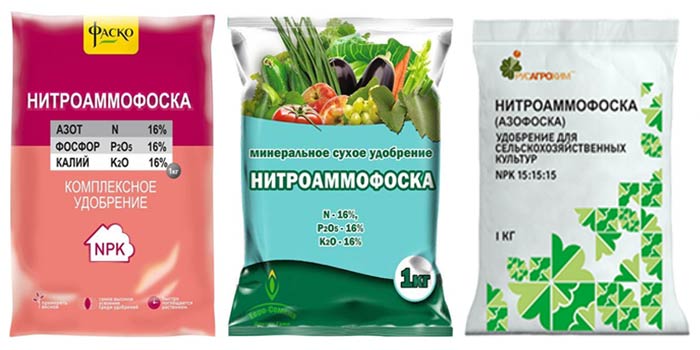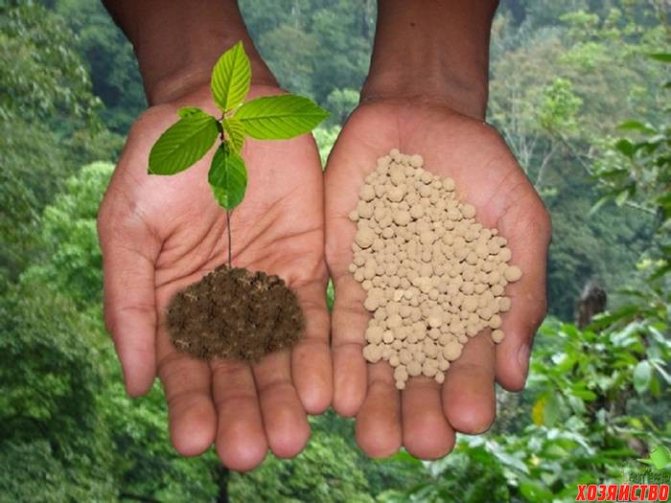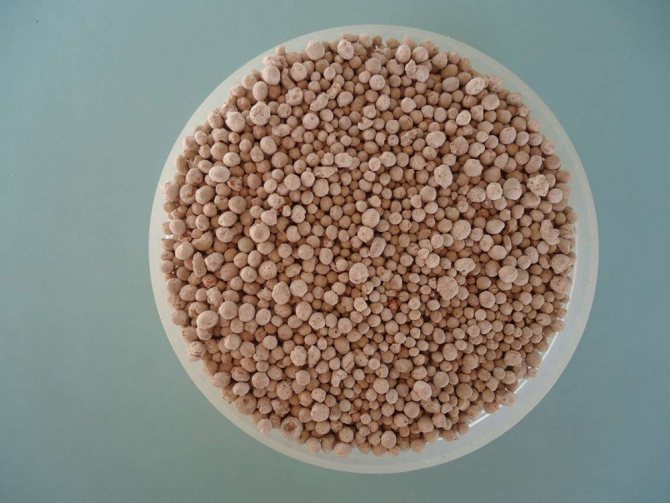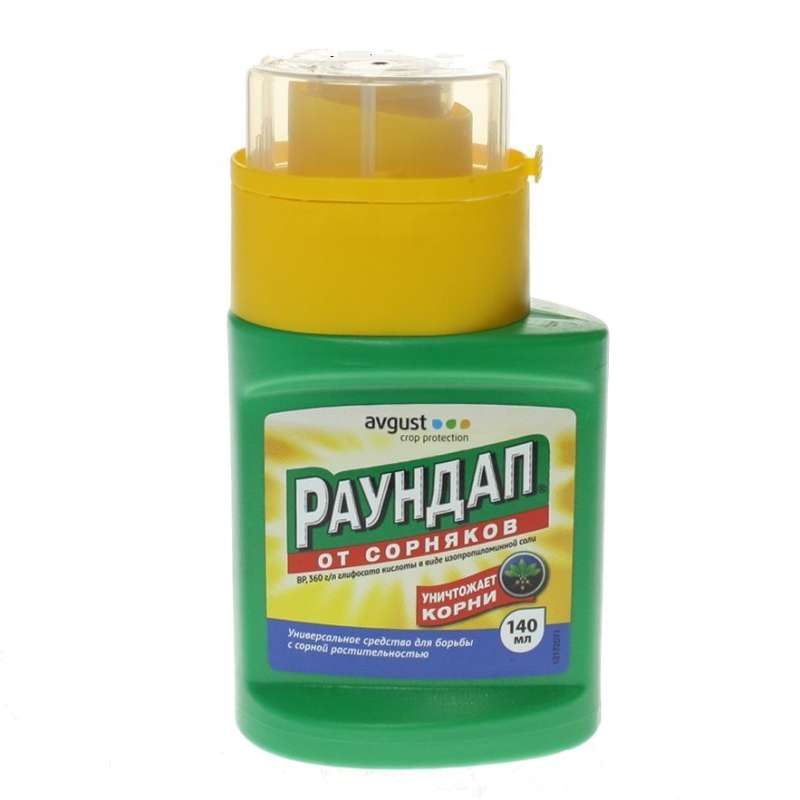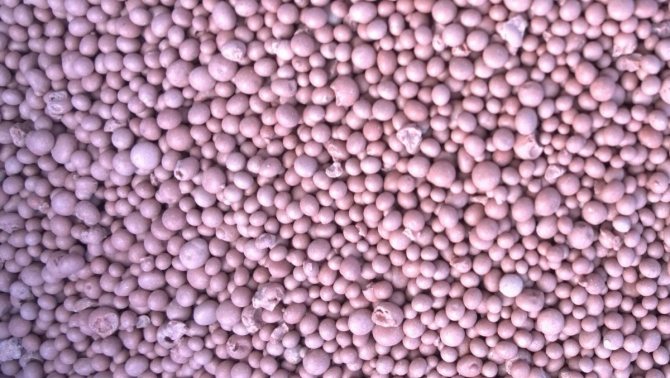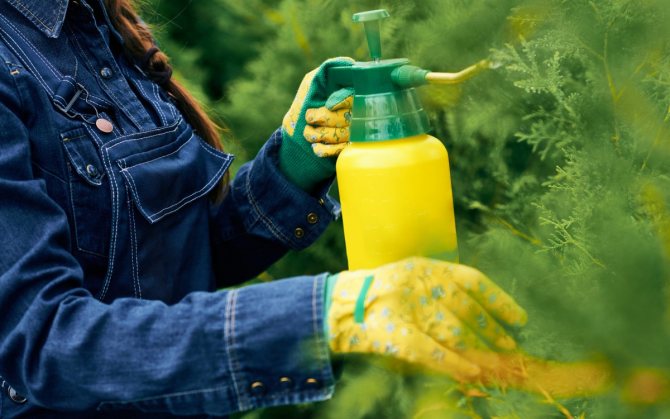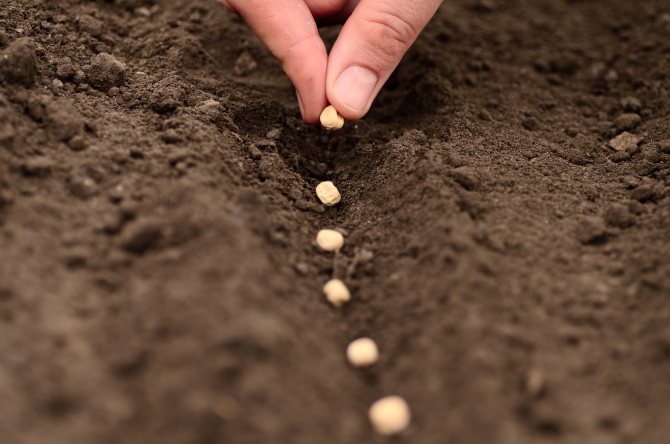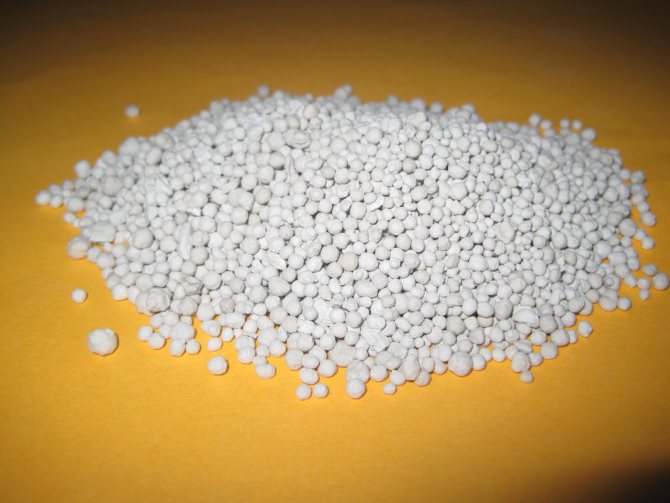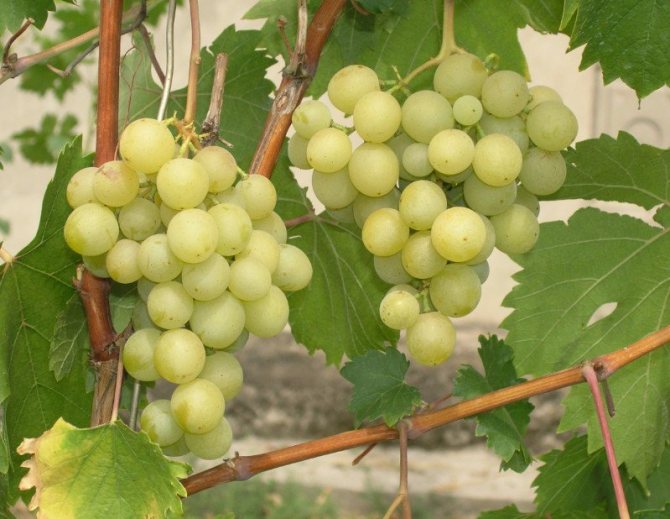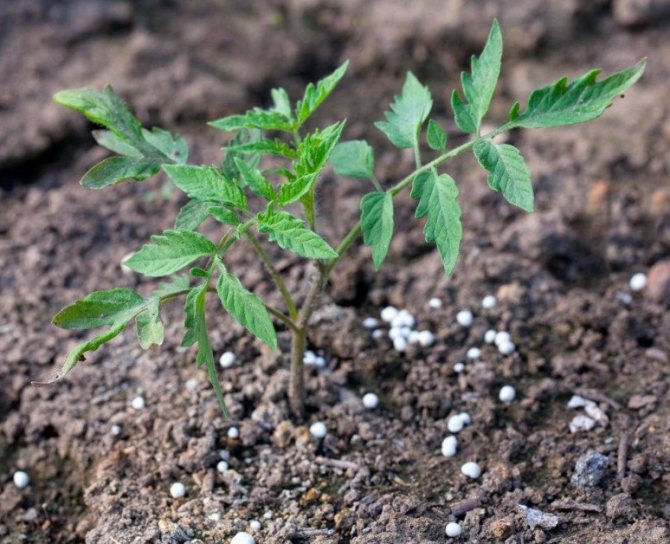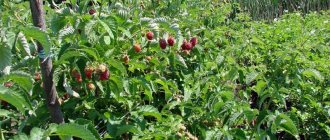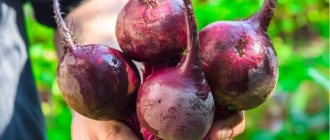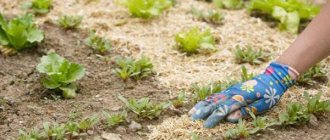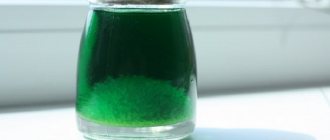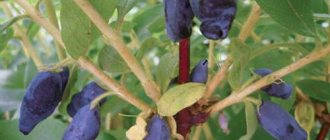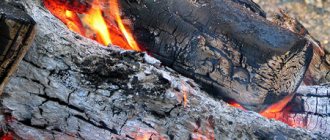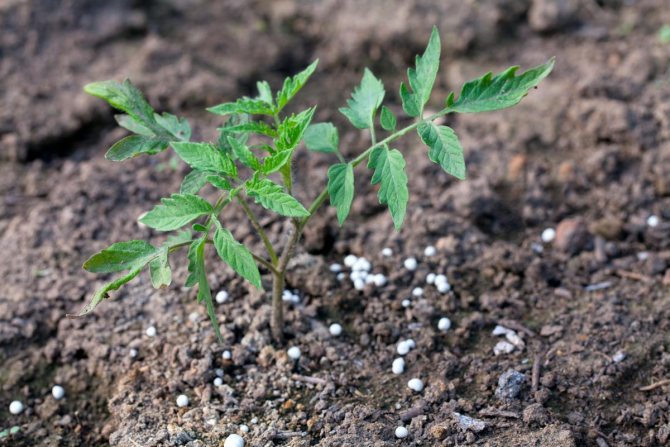
With the onset of spring, active growth and development of vegetation begins. This process requires the soil to be saturated with useful components that are vital for plants. To restore nutritional capacity, farmers feed the land with mineral fertilizers and additives. The use of Nitroammofoski fertilizer in summer cottages has gained popularity due to its complex content.
Fertilizer composition
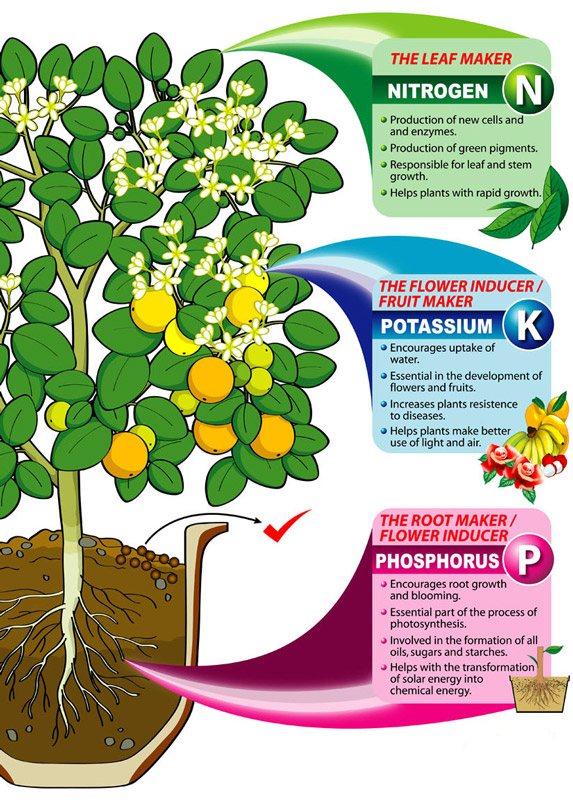

So the nitrogen so beloved by all plants is in the nitroammofosk in the form of an easily available compound, which makes the use of this fertilizing for different types of crops very effective. Of the elements vital for plant flora, this mineral compound includes phosphorus. It is present here in three forms: monocalcium phosphate (Ca (H2PO4) 2), dicalcium phosphate (CaHPO4 2H2O), and partly as water-soluble ammonium phosphate CaNH4PO4.
The basic substance Ca (H2PO4) 2 is perfectly soluble in nitric acid. This property allows phosphorus to be quickly released from the inert composition, and change to a form that is convenient for plant nutrition. This is one of the factors explaining the speed of action of nitroammophoska.
Interestingly, these phosphorus-containing substances (except for CaNH4PO4) are also used in the form of food additives. For example, dicalcium phosphate is one of the most common feedings in livestock and poultry farming, and monocalcium phosphate is used not only in agriculture, but also in the food industry, as a baking powder for dough.
Advantages and disadvantages
Like any mineral fertilizer, nitroammophoska has positive and negative sides. it highly effective, but sometimes aggressive substance that requires skillful handling... At the same time, it acts so actively on the development of the plant, spurring it on that users turn a blind eye to many disadvantages.
Pros:
- With long-term storage, the granules do not stick together, 100% friability remains throughout the warranty period;
- It is a highly concentrated fertilizer, where the proportion of active ingredients is at least 30% of the total weight;
- It is less fixed by the soil complex than one-component fertilizers;
- All three main nutrients are in one granule;
- It dissolves well in water;
- Increases the amount of harvest by 30-70% (for different types of crops, the value is individual).
Minuses:
- Has an inorganic nature of origin;
- Provokes the formation of nitrates in the soil;
- Refers to substances representing the third level of danger to humans. Highly flammable and explosive;
- Small shelf life.
Pros and cons of fertilizing with nitroammophos
Benefits of using nitroammophoska
- The main plus is a very high concentration of substances necessary to stimulate plant growth, as well as increase their productivity. Relative to the total mass of fertilizer, the proportion of substances necessary for plants is 30%.
- Nitroammofosk is extremely easy to dilute in water, which is its undoubted advantage.
- Each granule of nitroammophoska has three essential substances - N, P and K.
- It is excellently preserved and, when properly stored, retains its flowability.
- Thanks to the use of nitroammophoska, the yield sometimes increases up to 70% (depending on the crop itself).
Disadvantages of using nitroammophoska
- Along with the undoubted advantages, nitroammophoska has its own disadvantages. For example, not everyone likes that it is a chemical.
- With an excessive dose of nitroammophoska, nitrates are guaranteed to accumulate in the soil, they penetrate into vegetables, roots, fruits and berries and negatively affect the human body.
- Nitroammophoska is a flammable and explosive substance, therefore, you need to strictly monitor storage conditions and keep the nitroammophoska away from fire.
The most popular types of nitroammophos
The main ingredients in this agrochemical are permanent. But, depending on the brand, their ratio changes... Such a gradation exists in order to be able to more effectively apply fertilizer on soils with different compositions.
NPK 16:16:16
This brand contains equal shares of useful elements. Nitrogen, phosphates (assimilable) and potassium are equally divided here, 16% each. In total, the total share of active ingredients is 48% of the total mass, which is more than the total NPK value of many other brands of this mineral fertilizer.
The range of application of nitroammophoska 16:16:16 is quite wide. It is used for both pre-sowing and post-sowing soil fertilization for all types of plants. Produced at chemical plants in many parts of the country.
Depending on the type of soil, it is necessary to change the percentage composition of nitroammofoska, as already mentioned above. Therefore, a regionalization of the production of this agrochemical arose, which made it possible to provide specific regions with individually selected fertilizers.
For example, in Voronezh, which is famous for its chernozems, a plant owned by Minudobreniya OJSC produces stamps with a NPK ratio of 15:15:20, 13:13:24, 8:24:24. The potassium content is increased, and this is due to the peculiarities of local soils, which, with a similar ratio of nutrients, give the highest yields.
In the city of Nevinnomyssk, "C" grade nitroammophoska is produced. Many types of this fertilizer are produced here, with different proportions of the three main active ingredients, and additives to them. Agrochemicals of the following brands are in the range of JSC "Nevinnomyssky Azot": 10:26:26; 15:15:15; 17:17:17; 17: 1: 28; 19: 4: 19; 20: 4: 20; 20:10:10; 21: 1: 21; 22: 5: 12; 25: 5: 5; 27: 6: 6.
The price of a nitroammophoska depends on several factors - the composition, the cost of raw materials and the distance between the production and the consumer. Average for a popular brand NPK 16:16:16 it is about 10,000 rubles. per ton (data is current at the beginning of 2020).
Close "relatives" of nitroammofoska
There are a number of fertilizers that are very similar in action to nitroammophos. But there are small differences in their composition that affect the scope of these chemicals.
Azofoska
Fertilizer, which is also three-element, like the classic nitroammophoska. But azophos, in addition to nitrogen, phosphorus and potassium, also contains sulfur. Otherwise, these two mineral dressings are similar, not only in composition, but also in their effect on plants. The mass fraction of trace elements in relation to the entire volume of the mixture depends on the brand.
Ammofoska
This substance ((NH4) 2SO4 + (NH4) 2HPO4 + K2SO4) differs from other fertilizers from the subclass by the presence in its composition, in addition to the three classical elements (NPK), magnesium and sulfur, the latter element being at least 14% of the total composition. Another difference from the basic fertilizer is the possibility of using it indoors. Ammophoska does not contain chlorine and sodium, the amount of ballast substances is minimized.
Nitrophoska
The same NPK formula, supplemented with magnesium in this fertilizer. Nitrophoska loses to Nitroammophoska in such a parameter as aftereffect.It contains nitrogen only in the nitrate form, which is easily washed out of the soil, and the effect of fertilizer on plants is weakened very quickly.
But in nitroammofosk there are two types of nitrogen - the nitrate form and the ammonium form. So, the second significantly increases the duration of this mineral dressing.
Nitroammophos
But this fertilizer should not be confused with nitroammophos (NH4H2PO4 + NH4NO3 + KCL). Nitroammophos, aka nitrophosphate, with the formula (NH4H2PO4 + NH4NO3) is a dibasic element. Another difference is that there is no potassium in nitrophosphate, which limits its scope.
Features of use for different crops
The use of nitroammophoska allows you to increase the yield of vegetables and improve their taste, increase the resistance of young fruit trees to frost and strengthen the immunity of plants.
The composition and application of nitroammofoska makes it indispensable in the soil where the bear may be. This pest appears in areas fertilized with simple manure.
Some recommendations for the use of this fertilizer for specific garden crops and trees have been developed.
Tomatoes
Tomatoes from the use of fertilizer become stronger, their fruiting is accelerated. Tomato processing consists of four stages:
The use of superphosphate or potassium sulfate together with nitroammophosphate improves the yield.
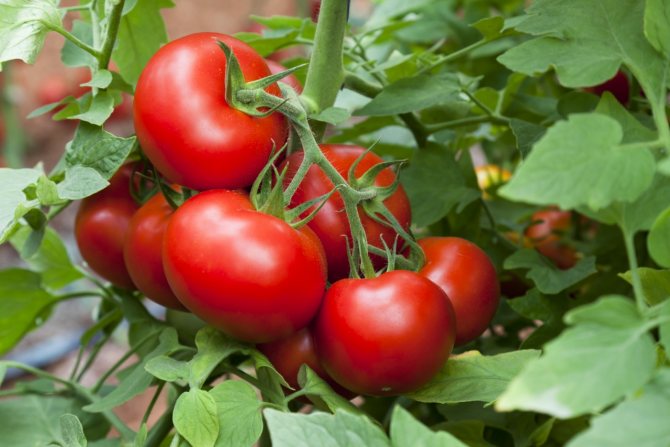

Tomatoes grow strong and healthy when fertilized
Potatoes
When planting potato tubers, the granules are applied directly to the hole. Take about one teaspoon of the substance mixed with the soil. The use of nitroammophoska fertilizer for potatoes contributes to the development of a more powerful root system and significant growth of bushes.
Another method involves watering the rows of potatoes with a solution of nitroammophoska. Consumption - 3 kg of dry fertilizer per one hundred square meters .
Cucumbers
The first time the beds are fertilized before planting, introducing the substance directly into the ground (30 g per sq.m.) ... Before the first ovaries appear, two tablespoons of fertilizer are dissolved in ten liters of water and watered on each bush. Per plant consume 300-500 ml .
Such treatment promotes the appearance of more ovaries and increases the fruiting period of the plant. It is worth noting a significant improvement in the taste of cucumbers.
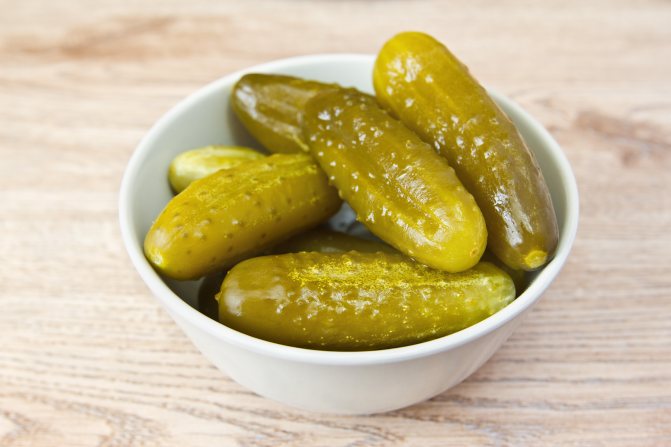

Cucumbers after using the drug significantly improve taste.
Horticultural crops
To fertilize fruit trees and bushes, the following activities are carried out:
They carry out regular feeding with nitroammophos and heat-loving grapes. The bushes are sprayed and watered, as are the fruit trees.
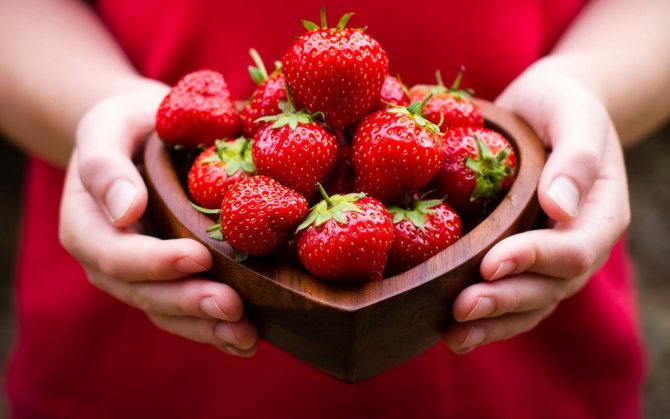

Strawberry really likes this type of fertilizer.
Rules for handling nitroammophos
This agrochemical is classified as explosive, therefore, you should avoid heating it. It must be stored in cold rooms made of concrete or brick, at an ambient temperature not exceeding 30C Celsius.
Air humidity should not exceed 50%. Mineral fertilizer nitroammofosk must be stored separately from others so that a chemical reaction does not occur with unpredictable (up to ignition and explosion) consequences. The use of heating devices and open flames in the room is strictly prohibited.
You cannot store this top dressing longer than 6 months.... It partially loses its beneficial properties. Also, after the expiration of the shelf life, this substance becomes more explosive and fire hazardous.
To transport the nitroammophoska, for safety reasons, it is allowed only by land transport, both in packed form and in bulk.
How much nitroammofoska should be applied for different plants?
The application rate depends on many parameters. From the type of plants, the composition of the soil, the presence of watering, and other related factors.But there are average values recommended by agronomists, and confirmed by many years of experience of various experimental and practical farms:
- Winter crops - 300-500 kg / ha;
- Spring crops - 300-400kg / ha;
- Sunflower - 150-200 kg / ha;
- Corn - 250 kg / ha;
- Rapeseed - 100 kg / ha;
- Beets (sugar and fodder) - 200-250 kg / ha.
Application rules
When choosing a mineral fertilizer, the main emphasis is on determining the type of soil. Nitroammofosk is used on most of them. It showed itself best of all on black earth and alumina. It should be borne in mind that the denser the composition of the soil, the longer the process of penetration of chemicals into the fertile layer takes. Therefore, nitroammofosku is introduced into clay lands as a top dressing in the fall, and in lighter, sandy lands - in the spring.
What can be fertilized and application rates
Despite the fact that the practice of using mineral fertilizers goes back several decades, novice gardeners and experienced agronomists still argue about the advisability of such fertilizing. Regular use of nitroammophoska causes the crop to accumulate chemicals. The statement is true if you do not adhere to the rules of fertilization. If you feed the plants in the garden throughout the season, the formation and ripening of fruits, nitrates will poison the crop. If you stop using nitroammophoska in a timely manner, the amount of nitrates in the fruits will remain within the normal range.
Note: nitrates are present even in organic fertilizers, their regular use can cause much more damage to the crop than a moderate application of mineral fertilizers.
Nitroammofoska is used to fertilize vegetable and berry-fruit crops, it is applied under fruit trees and shrubs, as well as in the fall when digging a site. Agronomists have developed general recommendations for the use of fertilizers:
- the average rates of top dressing per hectare are from 250 to 300 kg;
- for feeding industrial crops, depending on the nutrient content of the soil, ranges from 150 to 300 kg per 1 ha;
- together with digging up cultivated soil, 35 to 45 g or 3.5 to 4.5 kg per hundred square meters are applied for each square meter;
- uncultivated soil requires a larger amount of fertilizer - from 55 to 65 g per square meter, or from 5.5 to 6.5 kg per hundred square meters;
- as a top dressing for plants, from 15 to 20 g per square meter are applied;
- in the process of planting perennial fruit trees, from 350 to 400 g of nitroammofoska are poured into each hole;
- in spring and summer, fertilizer is applied in liquid form; one square meter of the plot will require from 50 to 60 ml;
- fertilizers are applied under fruit-bearing trees in accordance with the size of the plant, the average feeding rate is from 150 to 400 g.
For each plant, certain rates of nitroammophoska application have been developed.
| Agriculture | Application rates |
| Vegetables | 25-30 g / m2; 2.5-3 kg per weave |
| Potatoes (introduced at the stage of bud formation) | 25-30 g / m2; 2.5-3 kg per weave |
| Strawberries (applied twice - in early spring and at the end of flowering) | 10-15 g / m2; 1-1.5 kg per hundred square meters |
| Fruiting bushes (brought in between the rows when the snow melts) | 20-30 g / m2; 2-3 kg per weave |
| Garden trees (brought in around the circumference of the stamp circle when the snow melts) | 40-50 g / m2; 4-5 kg per weave |
Note: all specified standards are approximate, the exact dosage is indicated on the package, you should adhere to it. When using granules, they are mixed with earth and poured abundantly with water. If the soil is wet, it is not necessary to water the area.
Application rules
Nitroammofoska has proven itself perfectly on any, but it is better to use fertilizer on chernozems and clay soils. The denser the soil, the longer the top dressing penetrates into the deep layers. For this reason, in areas where clay prevails, fertilizer is applied in the fall, and in light, sandy soil - in the spring.
As a "shock therapy" for plants, foliar feeding is carried out.To do this, a few tablespoons of granules are dissolved in a bucket (10 liters) of warm water and crops are treated in the evening or during the day, if there is no bright sun. Water the area with plenty of water immediately after spraying. As a result, plants receive the necessary energy boost, their immunity is strengthened.
Application of nitroammophoska for potatoes
Potatoes need potassium to grow and form good tubers, for this reason nitroammofoska and potatoes are a classic combination. This top dressing for vegetable crops is the main one.
The choice of plant nutrition depends on several parameters:
- fertilizer brands, since the stores contain compositions with different ratios of chemicals;
- soil composition;
- type of soil.
The main amount of fertilizer is applied to the ground when planting potatoes. First, it is dissolved in water in accordance with the instructions on the package and the furrows are watered. You can also use a dry nitroammophoska, about 20 g of granules are poured into each well.
For tomato
Tomatoes respond well to the introduction of natroammofoska. This combination of chemicals not only increases the plant's resistance to diseases, but also improves the taste of the fruit - they become sweet and ripen evenly.
There is a specific schedule for applying top dressing for tomatoes:
- two weeks after planting the seedlings, fertilizing is carried out with liquid mineral fertilizer, the concentration is a teaspoon of nitroammofoska per 1 liter;
- the procedure is repeated ten days later, the solution is prepared very weak - half a teaspoon of fertilizer and a little potassium permanganate are added to one liter of fertilizer.
Fertilizers are applied every ten days until the first tomato ovary appears.
Note: after applying nitroammofoska, tomatoes are more resistant to diseases such as scab and stem rot. The first feeding is carried out with fertilizer with an equal amount of components (NPK 16:16:16), then you can use a composition that contains a larger amount of potassium. It is potassium that gives the tomatoes their sweetness.
For strawberries
Strawberries are the first berry to ripen in the garden, and the composition of the soil is one of the main conditions for a bountiful harvest. Strawberry bushes are fed in accordance with the developed scheme.
Scheme of feeding strawberries with nitroammophos
| The age of the bushes | Solution concentration and amount of fertilizer |
| When planting bushes | Pour two tablespoons of granules for each square meter |
| Biennial strawberry bushes (immediately after berry picking) | Add a tablespoon of fertilizer to a bucket of water (10 liters) |
| Three-year-old strawberry bushes (fertilize before buds appear) | Two tablespoons of nitroammophoska are added to a bucket of water, half a liter of solution is poured under each bush |
| 3-year-old bushes (immediately after harvest and leaf trimming) | A glass of ash and two tablespoons of nitroammophoska are dissolved in a bucket of water |
For grapes
Grapes are a resident of the southern regions and a lover of a warm climate. It is possible to grow it in colder regions, but subject to the introduction of mineral fertilizers. Nitroammophoska is used for root dressing and plant crown treatment.
The amount of fertilizer and its concentration for root feeding are indicated on the package. And to process the leaves, 2 tablespoons of granules are dissolved in 10 liters of water.
For roses
Roses are a decoration of any suburban area, they fill the garden with a wonderful aroma and bloom throughout the summer, but for this they need sufficient feeding. Nitroammophoska is diluted in water or applied in bulk under a bush to a depth of 2 to 4 cm, the granules should not come into contact with the roots of the plant. The concentration of the solution is the same as for feeding grapes.
Fertilizer is applied in the off-season - in spring and autumn.After winter, nitroammofoska activates the growth of bushes, and in the fall it helps to prepare for winter.
The use of nitroammofoska in garden plots
The practice of using mineral fertilizers in private household plots goes back more than a dozen years. But until now, many gardeners are wary of nitroammofosk, as they believe that its use helps nitrates to remain in the resulting crop. They are partially right, because if you use any mineral fertilizer until the very end of the plant's growing season, traces of chemicals will remain in its cells and tissues. But, if you stop applying in advance, then the nitrate residue in the product will be within the normal range.
In fact, nitrates are also found in organic fertilizers, and their excessive use can harm the environmental friendliness of products even more than the moderate use of mineral fertilizers.
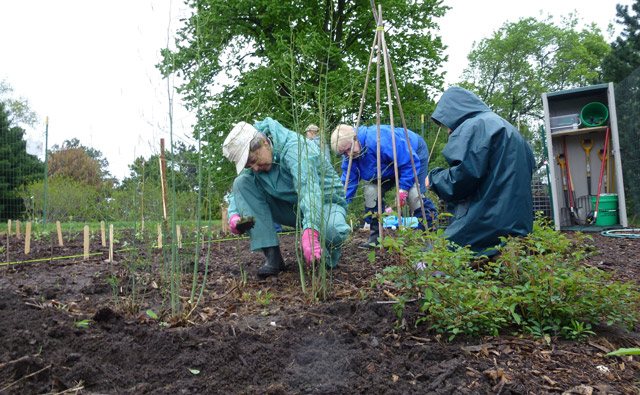

For private use of nitroammofoska, the following application rates are recommended:
- Potatoes - 1 sq. M. (or 4 holes) - 20 gr;
- Tomatoes - 20 per 1 sq. - 20 gr.;
- Berry crops (currants, gooseberries) - 65-70 gr. under the bush;
- Berry crops (raspberries, blackberries) - 35-40 gr. per sq. m .;
- Large fruit trees - 70-90 gr. along the edge of the trunk circle, mixing with the soil.
The recommended amount of top dressing may vary, depending on the growing season of the plant, the type of soil, and the timing of other fertilizers. It is necessary to consult the instructions for use in order to calculate the optimal value for each specific case.
Fertilizer nitroammofosk can be used in small doses for foliar feeding of fruit, vegetable and berry crops:
1-2 tablespoons of granules are diluted in 10 liters of warm (but not hot) water, and spray the plant in the evening, or in cloudy weather. After the procedure, it is necessary to make abundant watering, since direct foliar feeding, even with highly diluted nitroammophos, is, in some way, a shock therapy for the plant. It benefits the "patient" by strengthening his body and immunity. But in order for top dressing not to become a destructive factor, it is necessary to create comfortable conditions for recovery. It turns out a kind of tango with fertilizers - one step back - two steps forward.
The use of nitroammophoska for all types of garden crops, especially for tomatoes, has a healing effect on plants. Tomatoes are less sick with scab, root and stem rot, late blight. They should be fed with this fertilizer no more than twice a season. It is recommended to use NPK 16:16:16 the first time. The second time feeding is carried out during fruit setting. It is recommended to use a brand with an increased potassium content for it. This element is responsible for the production of plant sugars, and makes the fruit sweeter.
Another lover of nitrogen, phosphorus and potassium is grapes. As a result of many years of testing, it was proved that a southern inhabitant can successfully grow and bear fruit in central Russia. But this is possible only with timely feeding of the plant with both organic and mineral additives.
Fertilizer nitroammofosk is used for grapes in the form of root and foliar dressings. When applying root dressing, the amount should be calculated by referring to the instructions for use. But when carrying out foliar feeding, nitroammofosku must be diluted with water, in a proportion of 2 tbsp. spoons for 10 liters. water.
Effect of application
Excessive oversaturation of the soil with mineral additives and chemical-based fertilizers can cause the opposite effect to the positive one.
Fertilizer should be applied after reading the Nitroammofosk preparation and instructions for use, after weighing all the negative and favorable characteristics of the product.
The positive qualities of a mineral supplement include:
- The composition of the fertilizer contains all the components necessary for the growth and development of the “summer cottage flora”.
- The percentage of useful components in the fertilizer does not provide for its frequent use (it can be applied to the soil once a year - when sowing in spring or autumn).
- When interacting with water, the agent is able to form other homogeneous systems necessary for plants (to improve absorption).
- The chemical's versatility allows it to be applied in a variety of ways.
- Nitroammofosk has a long shelf life, during which the granules do not crumble or stick together, without losing their usefulness.
- Increase in soil productivity up to 70%.
- The substance does not possess toxic properties and is not explosive.
- When interacting with air, it does not oxidize.
Negative factors when using nitroammofoska are:
- Over-saturation of the soil with chemicals can cause excessive accumulation of nitrates in it, which negatively affects human health.
- Has a short shelf life (6 months).

